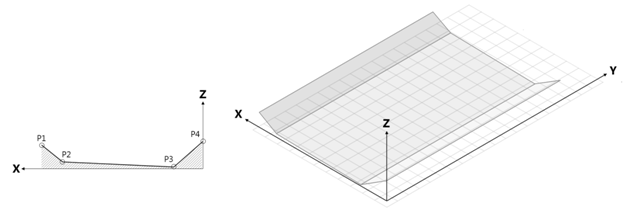3D Stockpiles
A 3D stockpile is a digital representation of a physical stockpile of mined materials, such as coal or ore. The representation is created using three-dimensional (3D) modelling and visualisation techniques, which help in calculating and monitoring the volume, mass and grade distribution of the stockpile, adjusted after each stacking or reclaiming transaction. This data enables mine managers to optimise material extraction, logistics, and quality control.
Important: Most stockpiles should be created as weighted-average-grade (WAG). If not carefully managed, using 3D stockpiles may create system performance issues.
3D Stockpile Geometry
Coordinate System
A Cartesian coordinate system is used for 3D stockpiles, where the axes correspond to:
- Z—The vertical axis of the model. Origin is at the bottom, value increasing upwards.
- X—The 'short' axis of the stockpile base. The stockpile 'width' lies along this axis.
- Y—The 'long' axis of the stockpile base. This is the axis parallel to the rail on which the stackers and reclaimers move. The stockpile 'length' lies along this axis.
The grid has a nominal resolution of 1 metre by 1 metre. Selecting a finer resolution results in larger data storage requirements.
Stockpile Base
The stockpile base is made up of two parts:
- A function that describes the base's cross-sectional shape along the X-axis
- A regular grid superimposed on the base, in the X-Y plane
The base does not need to be flat. CHASM allows for a non-regular base with the only restriction being that this shape is consistent along the Y-axis. The base can be thought of a cross-sectional shape in the X-Z plane, extruded along the Y-axis.
A stockpile can be viewed with the origin at the left, or mirrored horizontally with the origin at the right.

Stackers and Reclaimers
Each 3D stockpile must have an assigned stacker and reclaimer. See Stackers and Reclaimers.

